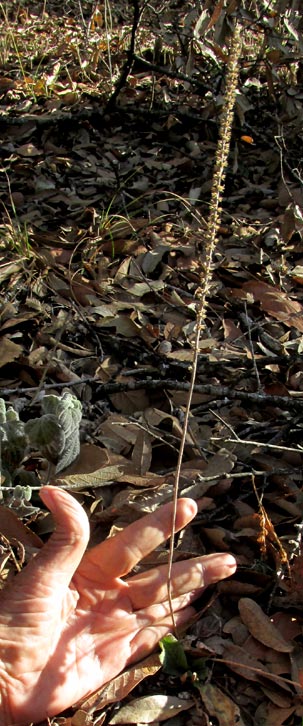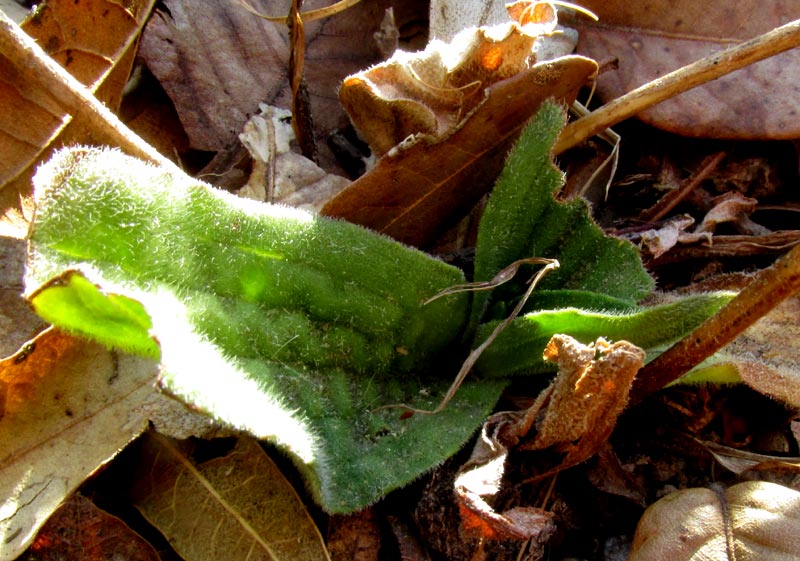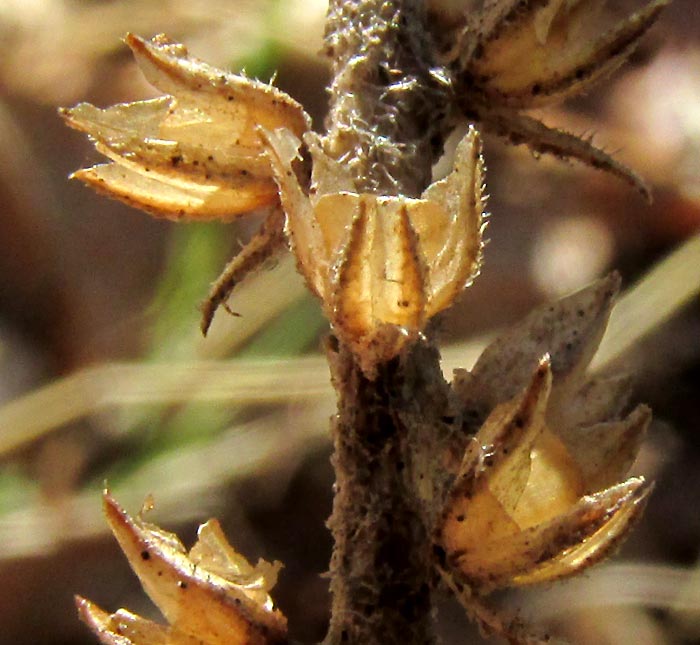Excerpts from Jim Conrad's
Naturalist Newsletter
entry from field notes dated April 16, 2022, taken in disturbed/reforesting borderline cloudforest within 1km of Valle de los Fantasmas, elevation ±2,320m (7600 ft), with limestone bedrock; about 40kms (24 miles), straight-line, ESE of San Luis Potosí, San Luis Potosí state, MÉXICO, (N22.06°, W100.62°)
MEXICAN PLANTAIN REMAINS & NEW SPROUTS

Now during the late dry season, the plant at the right confused me. At first I thought it was the dried-out, stiff, post-seed-dispersal remains of a small-flowered orchid similar to North America's Lady's-Tresses, genus Spiranthes. The highland oak woods with its thick carpet of last season's crunchy leaves felt right for many orchid species. However, as I steadied the plant for the above picture, the stiff stalk of the flowering part felt very rough-hairy, which didn't seem right for an orchid. But, what else could it be?
When I looked closely at the small, green tuft of leaves forming a rosette arising next to the stalk -- the stalk not arising from the rosette's center -- the hairiness seemed even more non-orchidy. A few orchid species do have hairy stems, but I couldn't think of any with tiny flowers arranged like this one's. The very hairy leaves, with most of their blade nibbled away, is shown below:

Note that the blades bear several conspicuous veins running parallel with one another for the leaves' lengths. With a hand lens, when the flowering stalk was examined, then for sure it was clear that this was no orchid:

Orchid flowers have six "perianth" parts, the perianth being the calyx and corolla considered together, especially when the calyx isn't clearly different from the corolla. When the calyx and corolla are easy to distinguish, then most orchid flowers have 3 sepals and 3 petals. The above picture shows the flowers' empty calyxes, the corolla having fallen away, and the capsular fruit having opened and lost all their seeds. And the calyxes in the picture have four sepals, not three. That simple fact means "not an orchid."
Once orchids were flushed from my head, the plant began looking more like a plantain. However, the plantains I know are weedy or alpine, not likely to occur in a mountain's oak woods.
The Plantain Family volume of the authoritative Flora del Bajío is finished. Since the Bajío lies on the south side of San Luis Potosí state, probably our plant would be featured in that work. And it was.
Here we have last year's remains, and this year's beginnings, of PLANTAGO AUSTRALIS ssp HIRTELLA, a wide-ranging and variable species occurring from arid Arizona in the southwestern US south to Chile and Argentina in South America. Since the species is found in the US, the Flora of North America graces the plant with the English name Mexican Plantain, though elsewhere I've seen it listed as the Brazilian Plantain, since it occurs there, too. Covering such a large area, as many as 16 subspecies have been recognized, and ours is ssp. hirtella.
And this species is at home in fir, pine, oak and oak-pine forests, as well as disturbed spots in those forest types, so here's a plantain that's not necessarily a weed. It occurs mostly between 1800-2900 m (5900-9200 ft) in elevation. Here we are at ±2,320m (7600 ft).
Traditionally Mexican Plantain has been used medicinally for various ailments, including eye inflammation, for superficial ulcers and wounds, plus it's considered an antiseptic and antibiotic. In 2002, Nayana Schuch Palmeiro and others published a study entitled "Propiedades analgésicas y antiinflamatorias del extracto hidroalcohólico de Plantago ausralis," in which they concluded, "The results indicated that the hydroalcoholic extracts of leaves, roots, and fruits of P. australis are endowed with anti-inflammatory and analgesic activities."